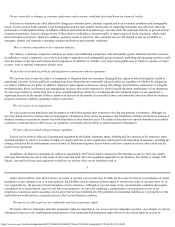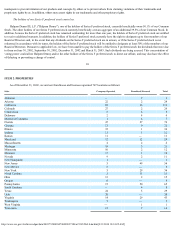Einstein Bros 2002 Annual Report Download - page 19
Download and view the complete annual report
Please find page 19 of the 2002 Einstein Bros annual report below. You can navigate through the pages in the report by either clicking on the pages listed below, or by using the keyword search tool below to find specific information within the annual report.
http://www.sec.gov/Archives/edgar/data/949373/000104746903027186/a2116520z10-ka.htm[9/11/2014 10:14:22 AM]
payment terms are considered past due. We determine our allowance by considering a number of factors, including the length of time trade
accounts receivable are past due, previous loss history, the customer's current ability to pay its obligation to us, and the condition of the general
economy and the industry as a whole. We write off accounts receivable when they become uncollectible, and payments subsequently received on
such receivables are credited to the allowance for doubtful accounts.
Deferred Tax Assets. We recorded a valuation allowance to reduce our deferred tax assets related to net operating loss carryforwards. We
limited the amount of tax benefits recognizable based on an evaluation of the benefits that are expected to be ultimately realized. An adjustment to
income could be required if we determine we could realize these deferred tax assets in excess of the net recorded amount.
Investment in Debt Securities. Investment in debt securities includes the 7.25% Convertible Debentures due 2004 of Einstein/Noah Bagel
Corp., which are classified as available for sale securities and are recorded at fair value. Fair value is based on the most recent quoted market
prices or, beginning in 2001 due to developments in the bankruptcy auction pursuant to Section 363 of the U.S. Bankruptcy Code of Einstein, the
estimated value of such debt securities realizable from the proceeds of the bankruptcy estate of Einstein.
Goodwill, Trademarks and Other Intangibles. We adopted SFAS No. 142, Goodwill and Other Intangible Assets, effective January 2, 2002.
SFAS 142 provides that goodwill and other indefinite-lived intangibles should not be amortized, but be subject to an annual assessment for
impairment, or more frequently if circumstances indicate potential impairment, through a comparison of fair value to their carrying amount. The
two-step approach to assess our goodwill impairment requires that we first compare the estimated fair value of each reporting unit that houses
goodwill to the carrying amount of the unit's assets and liabilities, including its goodwill and intangible assets. If the fair value of the reporting unit
is below its carrying amount, then the second step of the impairment test is performed, in which the current fair value of the unit's assets and
liabilities will determine the current implied fair value of the unit's goodwill.
In conducting our impairment analyses, we utilized independent valuation experts to perform the analyses and tests of our indefinite-lived
assets with respect to our reporting units. The test methods employed involved assumptions concerning useful lives of intangible assets, interest
and discount rates, growth projections and other assumptions of future business conditions. The assumptions employed were based on
management's judgment using internal and external data. We also utilized independent valuation experts to assist us in determining useful lives for
our intangibles other than goodwill, including the assessment that our Einstein trademarks have indefinite useful lives. Our determination that this
trademark, as well as our other trademarks, have indefinite useful lives is based on the fact that there are no legal, regulatory, competitive or other
factors that limit their useful lives.
21
The transitional and annual impairment analyses of goodwill conducted by us indicated that the fair value of the Manhattan Bagel Company
reporting unit (the only reporting unit with goodwill) as of December 31, 2002 and January 1, 2002 exceeded its carrying value. Thus, the
associated goodwill on our consolidated balance sheets as of December 31, 2002 and January 1, 2002 was not impaired, and the second step of the
impairment tests was not required. Additionally, the transitional and annual impairment analyses for our indefinite-lived intangibles (trademarks)
indicated that, in each instance, their respective fair values exceeded their carrying values as of December 31, 2002 and January 1, 2002.
Derivative Instruments. Effective January 1, 2000, we adopted SFAS No. 133, Accounting for Derivative Instruments and Hedging
Activities. SFAS 133 requires that all derivatives be recognized in the balance sheet at their fair value. Changes in the fair values of derivatives
that do not qualify for hedge accounting under SFAS 133 are recognized through earnings. In conjunction with certain debt and preferred stock
issuances in 2000 and 2001, we issued freestanding warrants and rights to receive additional warrants based either on the passage of time or upon
the occurrence or non-occurrence of certain contingent future events ("contingently-issuable warrants"). We determined that certain of these
freestanding warrants, for a period of time in 2001, and contingently-issuable warrants could not be classified within stockholders' equity based on
the application of the criteria in EITF Issue 00-19, Accounting for Derivative Financial Instruments Indexed to, and Potentially Settled in, a
Company's Own Stock, and accordingly have classified those warrants as a liability in the balance sheet. Further, those warrants classified as a
liability are subject to the provisions of SFAS 133, including the requirement to adjust the recorded amount of the warrants to fair value at each
balance sheet date, with changes in fair value being recognized in earnings. To the extent that the number of freestanding warrants and the
maximum number of additional warrants that could potentially be issued in the future exceed the maximum number of authorized shares (the
"Share Cap") at the time the debt or preferred stock instrument is issued, we determine the classification of, and accounting for, the freestanding
and additional warrants as follows: (1) freestanding warrants (those that are immediately exercisable) are considered first for equity treatment, to
the extent of the maximum number of authorized shares; (2) among various outstanding instruments, those with the earlier issuance dates are
considered first for equity treatment; and (3) contractual priorities are considered where applicable.
Issued $0.01 warrants classified as liabilities, if any, are recognized in the balance sheet at their fair value, as determined periodically based on
quoted market prices of the underlying Common Stock. As of December 31, 2002, January 1, 2002, and December 31, 2000, there were no issued
warrants classified as liabilities. Contingently-issuable $0.01 warrants classified as liabilities are also recorded at fair value based on quoted market
prices of the underlying Common Stock and considering the probability of issuance, our assessments of the probability of refinancing our debt and
























